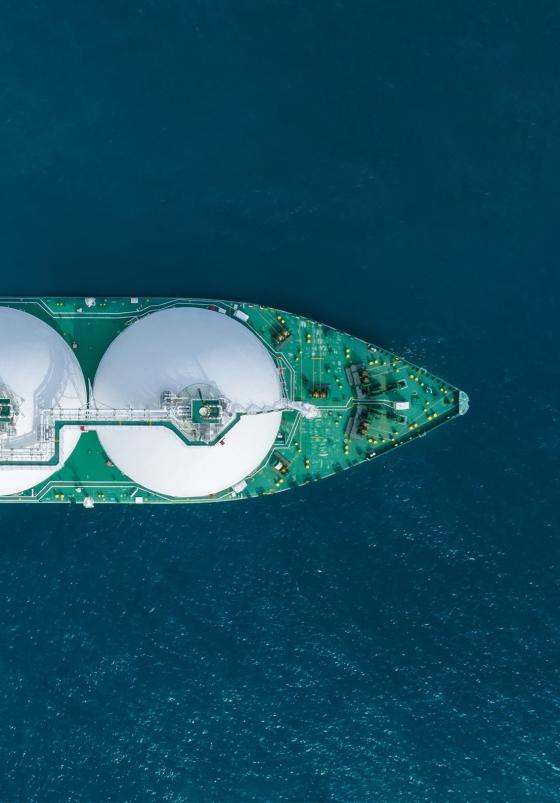of imported LNG maintains the EU’s status
as the top LNG importer in 2023
Analysis of the European LNG market developments
2024 Market Monitoring Report
What 2023 trends did ACER’s monitoring find?
Europe:
- During the energy crisis, EU successfully secured gas supply and diversified gas imports away from Russia, with LNG playing a key role in this shift.
- Since 2022, over 50 bcm of new LNG import infrastructure eased supply congestion and helped narrow the price gap between European gas hubs and LNG spot prices.
- EU is the top global LNG import market. In 2023, EU Member States imported 134 bcm of LNG, making up 42% of total EU gas imports. The breakdown of LNG imports varied by country, with France being the largest importer at 30 bcm.
- EU LNG demand is likely to reach its peak in 2024. This is due to reductions in structural gas demand driven by the EU’s ambitious decarbonisation goals.
- In 2023, EU imported 18 bcm of Russian LNG, mostly via long-term supply agreements signed before 2022. At least 1 bcm (but possibly more) of this Russian LNG is re-exported to Asian markets through LNG reloads.
- The targeted gas demand cut scenario of REPowerEU (if it materialises by 2030) could shift EU's reliance on the spot LNG market, turning a 49 bcm ‘under-contracted’ status in 2023 to an ‘over-contracted’ position of 30 to 40 bcm between 2027-2030. Under-contracted means insufficient long-term contractual commitments increasing buyers’ reliance on the more volatile spot market. Over-contracted means the long-term contracts exceed the demand. Nonetheless, the surplus in long-term commitments shouldn't pose a burden thanks to the flexibility of free-on-board (FOB) contracts, which enable surplus LNG to be sold on the spot market or redirected elsewhere.
- Around 75% of the new regasification capacity added in the EU since 2022 are Floating Storage and Regasification Units (FSRUs). This allows for the potential repurposing or relocation of these floating infrastructure should their utilisation significantly decline.
US restrictions on LNG exports:
- Global LNG export capacity is massively expanding. By 2030, more than 200 million tonnes are projected to be added, equivalent to approximately 50% of the current annual LNG trade volumes. The United States will lead capacity construction, unaffected by the recently announced pause on granting new LNG export approvals.
Prices and indexation:
- Contrary to the general belief, the EU remains more dependent on long-term than on spot LNG contracts. TTF serves as the predominant indexation term for EU spot contracts (64%), but not for long-term ones (where Henry-hub and Brent indexations are dominant).
What does ACER say?
Given the EU reliance on LNG imports, coupled with the strong influence of spot LNG volumes in determining the marginal prices at EU gas hubs, ACER makes recommendations aimed at improving transparency, competition and flexibility in European LNG terminals.
- Transparency: LNG System Operators (LSOs) must implement transparent and consistent reporting of operational data, supported by secondary capacity allocation platforms.
- Competition enhancements:
- Not allocating the total capacity in the first round to reserve some for short-term needs.
- Limiting the amount of primary capacity dominant users can receive in first rounds.
- Implementing market-based allocation methods like auctions, especially when demand exceeds offered capacity.
- Promote flexibility: encourage market entry by offering unbundled products and flexible send-out options to optimise supply. Virtual trading systems, like those in Spain, show positive outcomes.
What’s next?
Join our webinar to learn more about the evolving role of LNG in the European energy market.
When? 30 April 2024, 10:00 to 11:00 CET (online). Register for free here.
Analysis of the European LNG market developments

Highlights
-
134 bcm
-
50 bcm
of new LNG import capacity (since mid-2022) helped ease congestion and align spot & hub prices in 2023
-
200 Mt
of new LNG production capacity
is expected by 2030
Report
ACER’s monitoring shows EU LNG imports might be near its peak
This first ACER LNG Market Monitoring Report (MMR) analyses the European LNG market developments in 2023. The report:
- describes the most recent dynamics in the global LNG market;
- provides insights into the latest trade developments and EU LNG contractual arrangements; and
- sets out recommendations on the future role of gas and regulation of LNG terminals.
It highlights how EU’s increased reliance on LNG is likely to reach its peak in 2024 and it shows LNG’s significant impact on prices and flows in the EU energy market.
Highlights
The accompanying presentation provides a high-level overview of key trends and data shaping the EU LNG market in 2023.
Dive in to gain essential insights!
Webinar
At this webinar, ACER:
- presented the main findings of the report;
- highlighted recent developments in the global LNG markets;
- discussed the LNG outlook for Europe up to 2030;
- hosted a panel discussion with selected speakers; and
- addressed stakeholders’ questions.
Check out the slides used during the webinar.


